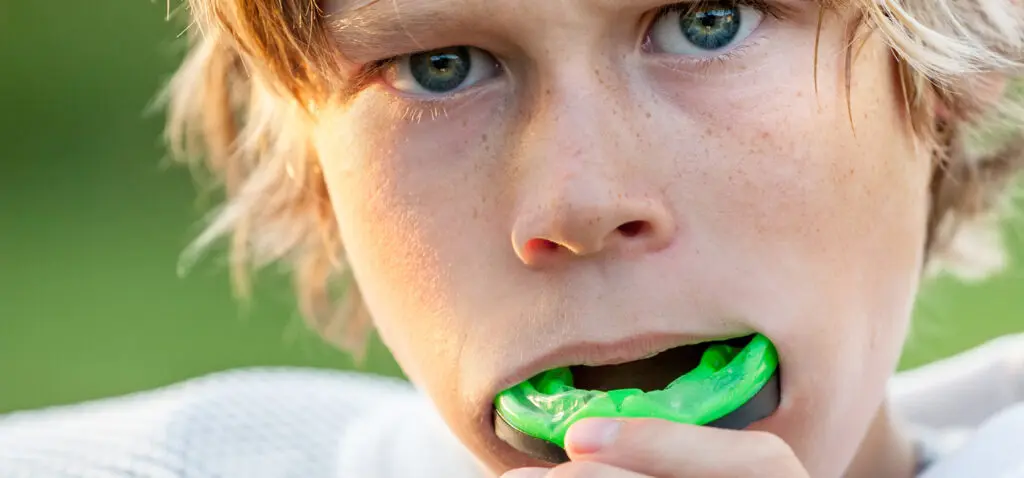Reviewed by Dr. David Sentelle, DMD, PhD, MPH
Reading time: four minutes
Mouthguards do a great job protecting your child’s teeth, but they need protection too—from bacteria and buildup. Without regular cleaning, a mouthguard can start to smell, feel uncomfortable, and even lead to gum irritation or illness.
In this blog you’ll learn how to clean your mouthguard in 4 easy steps. We explain why it’s important to clean it every time you use it and share tips on how to store it and when to replace it.
Table of Contents
- Why Cleaning Your Mouthguard Matters
- Clean Your Mouthguard in 4 Easy Steps
- 1.Rinse After Every Use
- 2.Brush It With a Soft Toothbrush
- 3.Soak It Once a Week
- 4.Let It Air Dry Completely
- How to Store Your Mouthguard
- When to Replace a Mouthguard
- Custom Mouthguards in Frisco at Lonestar Kid’s Dentistry
- FAQs
Key Takeaway
Clean your mouthguard daily, soak it weekly, dry it thoroughly, and store it in a breathable case. Replace it when it no longer fits, smells, or functions like it should.
Why Cleaning Your Mouthguard Matters
A clean mouthguard keeps your teeth and gums safe from bacteria buildup. Every time you wear a mouthguard, your saliva, food particles, and bacteria coat the surface. Without regular cleaning, this can lead to:
- Foul odor and bad taste
- Bacterial infections and gum irritation
- Discoloration and early breakdown of the mouthguard material
No matter what you use your mouthguard for, daily cleaning is essential.
Clean Your Mouthguard in 4 Easy Steps
Cleaning your child’s mouthguard properly helps prevent bacteria buildup, odor, and wear. Here is how to do it step by step.
1.Rinse After Every Use
As soon as you remove it from your mouth, rinse it under cool water. This quick step washes away loose saliva, food particles, and bacteria before they harden on the surface. Don’t use very hot water, as this can warp the plastic and encourage bacterial growth.
2.Brush It With a Soft Toothbrush
Use a soft-bristled toothbrush and mild antibacterial soap or non-abrasive toothpaste to clean all surfaces. Gently scrub both the inside and outside, making sure the bristles reach all the way to the bottom. If you use soap, you may want to have a separate toothbrush for the mouthguard.
3.Soak It Once a Week
Once a week, soak the mouthguard in a cup of warm water mixed with a retainer cleaner like Polydent for Retainers, Retainer Bright Cleaning Tablets or a capful of alcohol-free mouthwash. This deep cleaning step helps reduce bacterial growth and bad breath. Hydrogen peroxide is another effective alternative for disinfecting naturally. Always rinse the mouthguard thoroughly with cool water after cleaning.
4.Let It Air Dry Completely
After cleaning, pat the mouthguard dry with a towel and leave it in a well-ventilated area to air dry. Storing it while still damp increases the risk of mold and odor. Daily cleaning and proper drying are key to keeping the mouthguard clean and safe to use.
How to Store Your Mouthguard
Proper storage extends the life of your mouthguard and keeps bacteria out.
- Use a ventilated case: Always store it in a container that allows air flow to prevent moisture buildup.
- Clean the case regularly: Wipe it down with soap and water once a week.
- Keep it away from pets: Dogs especially love to chew on mouthguards.
When to Replace a Mouthguard
Even the best-kept mouthguards don’t last forever. Here is when to get a new one:
- Visible cracks or tears
- Loss of shape or poor fit
- Persistent odor even after cleaning
- Changes in your bite or dental work
In general, replace your mouthguard every 6–12 months, or sooner for kids who are still growing.
Custom Mouthguards in Frisco at Lonestar Kid’s Dentistry
At Lonestar Kid’s Dentistry, we help children and teens protect their teeth both in and out of the dental chair. From nightguards to custom-fit sports mouthguards, we provide professional guidance for long-lasting oral health.
If your child needs a high-quality, professionally fitted mouthguard, we can help. Our custom options offer better comfort, protection, and durability than store-bought versions.
To book an appointment at our pediatric dental office in Frisco, call (214) 618-5200 or visit us at 6801 Warren Parkway, Ste 115, Frisco, TX.
📍Other locations
Lonestar Kid’s Dentistry in McKinney, TX
Lonestar Kid’s Dentistry in Prosper, TX
FAQs
To deep clean your mouthguard, soak it in a mixture of equal parts white vinegar and hydrogen peroxide for about 30 minutes. This solution breaks down bacteria and odors effectively using natural ingredients. Rinse it thoroughly with cool water afterward and let it air dry completely. Doing this once a month adds an extra layer of freshness and disinfection.
You can, but just make sure it isn’t a really abrasive toothpaste or a whitening toothpaste.
Denture cleaning tablets, retainer tablets, denture foam, antibacterial soap, or alcohol-free mouthwash mixed with warm water are all excellent options for cleaning a mouthguard. These solutions remove buildup and help prevent bad breath and bacterial growth. Choose products that are gentle and free from harsh chemicals.
No, do not boil your mouthguard to clean it. Most mouthguards are not designed to withstand high heat, and boiling can cause the material to warp or lose its shape. A warped mouthguard will no longer fit properly and may no longer offer the protection your child needs. Stick to cleaning with cool or warm water and a gentle cleanser, and always let it air dry completely.
